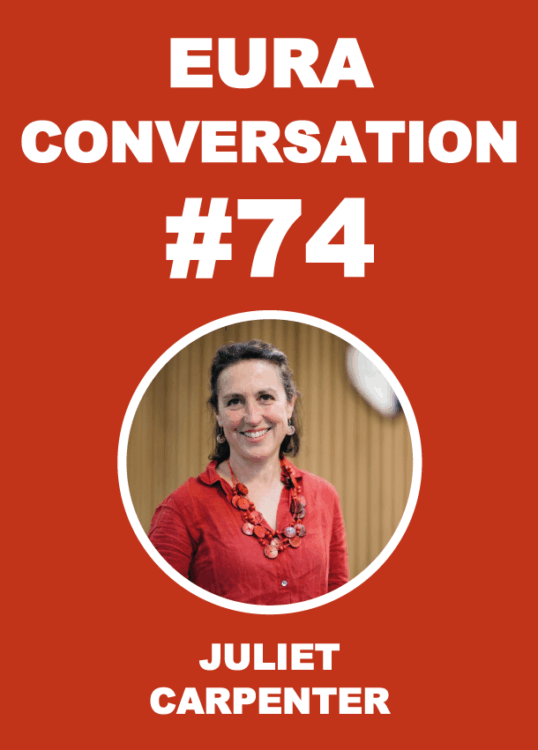
CIFAR Azrieli Global Scholars – Call for Applications 2026/28
27/09/2025
Urban Regeneration Talk #8, United Kingdom
22/10/2025Conversation #76
Multiresilient and multiadaptive places
by Marichela Sepe
Sapienza Università di Roma - DICEA and ISMed - CNR, Italy
 Resilience is widely used across disciplines thanks to its compatibility with complexity theories, ranging from economics and ecology to political science, cognitive science, technology, and spatial planning. Zolli and Healey’s (2021) definition of resilience as “the ability of a system, company or person to maintain its fundamental purpose and integrity in the face of radically changed circumstances” bridges ecological and sociological perspectives (Bohland et. Al., 2019; Pizzo, 2015). Cities, however are not uniform spaces with randomly distributed populations; rather, they are structured environments shaped by socio-economic inequalities. Thus, describing an entire city as resilient is not straightforward. The experience of the Covid-19 pandemic clearly demonstrated that vulnerabilities, safety concerns, and varying levels of resilience vary not only between different cities but also within individual neighborhoods (Sepe, 2023, 2024).
Resilience is widely used across disciplines thanks to its compatibility with complexity theories, ranging from economics and ecology to political science, cognitive science, technology, and spatial planning. Zolli and Healey’s (2021) definition of resilience as “the ability of a system, company or person to maintain its fundamental purpose and integrity in the face of radically changed circumstances” bridges ecological and sociological perspectives (Bohland et. Al., 2019; Pizzo, 2015). Cities, however are not uniform spaces with randomly distributed populations; rather, they are structured environments shaped by socio-economic inequalities. Thus, describing an entire city as resilient is not straightforward. The experience of the Covid-19 pandemic clearly demonstrated that vulnerabilities, safety concerns, and varying levels of resilience vary not only between different cities but also within individual neighborhoods (Sepe, 2023, 2024).
Similar to resilience, the concept of adaptivity also suffers from interpretative ambiguity. Terms such as adaptive planning, adaptive governance, adaptive management, institutional adaptation, and adaptation of urban form—whether in public spaces or buildings—reflect the many ways this concept has been employed, each time carrying a slightly different meaning (De Roo et Al., 2020).
This makes it valuable to introduce the idea of multi-resilience, understood as a system’s ability to respond to the co-occurrence of multiple risks. This requires taking into account local specificities, the particular nature of each risk, and the inclusive involvement of various stakeholders, with the aim of restoring the system to its prior condition while considering all these factors. Along similar lines, the concept of multi-adaptation can also be defined: a system’s capacity to react to unexpected and multi-risk situations by establishing a new equilibrium that integrates territorial characteristics, risk typologies, actors involved, and emerging needs in an inclusive manner (Sepe, 2024).
These definitions formed the conceptual basis for developing an analytical and design methodology aimed at identifying principles for multirisk resilience and adaptive spatial design. This Conversation pursues two main goals:
- to propose an original method for identifying multiple risks in public spaces and for planning interventions that foster both adaptation and enhancement of cultural assets;
- to establish guidelines for multi-resilient planning.
The proposed methodology for analyzing multirisk contexts unfolds in nine phases, divided into five dedicated to analysis and four to design. These include: identifying individual “urban” risks; examining contributing factors; assessing the combined effects of risk coexistence; administering risk-perception surveys; analyzing adaptation-related plans, projects, and policies; evaluating potentials and strengths; conducting multirisk analyses; defining flexible areas; and proposing multi-resilient/multi-adaptive design interventions.
Case studies used to test this methodology have yielded guiding principles for multi-resilient and multi-adaptive planning. These principles are grounded in the notion that risk can serve as an opportunity to reassess and improve territorial features, framing resilience as a driver of sustainable regeneration. The case studies considered include: Cittaducale and Leonessa (Lazio Region), Siena, Naples, Paris, Copenhagen, Madrid, and New York. Each was selected for its exposure to one or more current or potential risks: seismic hazard and depopulation in Cittaducale and Leonessa; mass tourism and globalization in the historic centers of Siena, Naples, and Madrid; flooding and potential erosion of local identity in Paris, and mass tourism in Copenhagen and New York.
The principles include:
- Risks and potential damages must be identified both in relation to single events and to multiple events that may occur simultaneously.
- The perception of risk held by the population—or, more broadly, by users of a place—represents a crucial factor in risk analysis and must be assessed through dedicated questionnaires.
- Vulnerable individuals should receive particular attention, both in terms of understanding their perception of risk and in designing adaptation measures tailored to their needs.
- The assessment of a site’s urban qualities—such as cultural heritage, materials, and facilities—must be integrated into multi-resilience and adaptation projects or policies, so that these assets can be transformed into opportunities to enhance liveability.
- Multi-resilience and multi-adaptation projects must be subject to continuous monitoring, enabling anticipation of sudden events and ensuring sustainable responses.
- Flexibility constitutes a key feature of multi-resilience and adaptation and should be understood at multiple scales (from individual buildings to the entire city) and across different factors, integrating urban, socio-economic, cultural, and environmental dimensions.
- A multi-resilience and adaptation strategy cannot be universally applied, even where risks appear similar. Each context—whether a historic centre, a suburban area, or a regeneration zone—has unique characteristics that must be respected.
- In the context of multi-adaptation design, ensuring accessibility to all public spaces must be a priority. This means that every environment, area, or structure intended for public use should be designed to be easily accessible to people of all ages and with varying physical, cognitive, and sensory abilities.
- The communication of risks, as well as of related projects, plans, and policies, must be designed to be accessible and appropriate for all age groups and abilities.
- All measures adopted—or planned—in response to crises of various kinds should be clearly and widely disseminated through dedicated tools such as web portals, mobile applications, social media, sensors, and interactive maps.
Accordingly, two questions could remain open:
- If multiple risks arise at the same time, how should we decide which one to prioritize, or should all be addressed simultaneously? And if addressing them all at once is the best choice, what are the most effective planning tools to manage them?
- If the perception of risks is an important factor to consider, how should we decide which types/categories of stakeholders to interview?
References:
Bohland, J. R., Davoudi, S., Lawrence, J. L. (Eds.). (2019). The resilience machine. New York: Routledge. De Roo, G., Yamu, C., Zuidema, C. (2020). Handbook on planning and complexity. Cheltenham, UK: Edward Elgar Publishing. Pizzo, B. (2015). Problematizing resilience: Implications for planning theory and practice. Cities, 43, 133–140. Sepe, M. (2023). Assessing flexible places for adaptive urban design: A new method and the case of Cittaducale. Journal of Cultural Heritage Management and Sustainable Development, 17(6), 286–297. Sepe, M. (2024). Measuring Uncertainty: Facing Place Mutations Sustainably. WIT Transactions on Ecology and the Environment, 262. Zolli, A., Healey, A. M. (2012). Resilience: Why things bounce back. New York: Free Press.







Thank you very much for sparking this conversation about your project on multi-resilience and multi-adaptation. I believe that your project and this blog post will be of interest to many colleagues in EURA and beyond because cities are indeed the spaces where many of today’s poli-crises land the hardest. Below, I would like to share with you a few reactions that I had to your blog:
First, when it comes to the principles, I was surprised that “social capital” didn’t make it into the list as principles. Studies of disaster resilience seem to suggest that neighborhoods with higher social capital also “weather the storm” better. From Daniel Aldrich’s study of tsunamis in Japan to Eric Klinenberg’s “autopsy” of the Chicago heatwaves, again and again we find evidence that suggests that possessing strong social capital is fundamental for resilience, especially in less affluent neighborhoods.
Second, and connected to the idea of affluence and inequality, I find it interesting that the definition of multi-resilience still has an “ ultimate goal of restoring the system to its original condition.” What I mean by this is if the inequalities of the original condition leads to multi-risk vulnerabilities – should we not aim to “bounce forward” rather than “bounce back” (to borrow from other resilience scholars)?
Finally, in a very self-serving way – I wonder how this idea of multi-resilience and multi-adaptation principles jives with and contributes the many new (and not so new) ideas around adaptive resilience and transformation that we in the urban climate governance sphere are increasingly engaging. Would you have any thoughts on that?
Thank you for giving me the change to engage with you.
Thank you very much for your reflections. I truly appreciate your engagement with the ideas of multi-resilience and multi-adaptation, and your comments open up important avenues for further dialogue.
On your first point about social capital: I fully agree that this is a crucial dimension. I see social capital as both a principle in its own right and a cross-cutting enabler that strengthens the effectiveness of other resilience strategies. It is definitely something that deserves explicit recognition in the framework of multi-resilience.
Regarding your second point on bouncing back versus bouncing forward: this is exactly why I have emphasized multi-resilience not only as the ability to restore a system to its prior condition, but as a way to do so while explicitly considering multiple risks, local specificities, and the distributional implications of resilience strategies. In this way, “restoring” does not simply mean reproducing pre-existing inequalities, but instead invites a critical reflection on how to address those vulnerabilities and potentially transform them. In other words, multi-resilience opens the space for combining restoration with transformation where needed.
Finally, in relation to your third point about adaptive resilience and transformation: I see multi-resilience as highly complementary. It provides a lens for understanding how multiple, co-occurring risks interact and how governance responses must account for this complexity. At the same time, by stressing inclusiveness and context-specificity, it aligns closely with the adaptive and transformative dimensions that many in the urban climate governance community are now exploring. My hope is that multi-resilience can contribute by offering a more integrated framework that connects these strands.
Thanks Marichela for sharing these ideas on urban resilience. I have a question which develops a point made by Le Anh: Do we actually want to enable cities to ‘bounce back’ after a disaster? For example, if a city is riven with inequality and is suddenly flooded it would be difficult to argue that efforts should be made to return the city to its ‘original condition’ ie recreate the inequality that existed before the flood. In making this point I draw on Ed Goetz’s work on what happened to New Orleans after ‘Hurricane Katrina’ devastated the city in 2005. In his book – ‘New deal ruins: Race, economic justice and public housing policy’ (2013) – Ed explains how the so-called ‘resilience strategy’ that was implemented after the flood had an enormously adverse impact on poor communities in the city. The strategy was, unfortunately, used to sustain an attack on the very idea of public housing in the city.
Perhaps a new question emerges for future urban research on resilience: Can urban resilience scholars pay more attention to the distributional consequences of the strategies they co-create with local stakeholders?
Lastly, in my own work on city and community leadership I have found the concept of transformation to be particularly helpful. Transformation means making a thorough and dramatic change in form and/or character. It is, in a way, the opposite of ‘bouncing back’. Most important, it draws attention to the nature of the political choices that need to be made. Does transformation feature in urban resilience thinking these days, I wonder?
Thanks, again, for sharing your ideas.
Thank you for your stimulating contribution. I find the distinction you propose between “bouncing back” and transformation very interesting, as well as your emphasis on the distributional consequences of resilience strategies.
In this very direction, I have introduced the concept of multi-resilience, understood as a system’s ability to respond to the co-occurrence of multiple risks. As I have written, this approach requires taking into account local specificities, the particular nature of each risk, and the inclusive involvement of a plurality of stakeholders, with the aim of restoring the system’s conditions while considering all these factors.
In this sense, multi-resilience is not limited to a simple return to a “previous state,” but opens up the possibility of integrating equity, transformation, and social justice into urban resilience strategies.